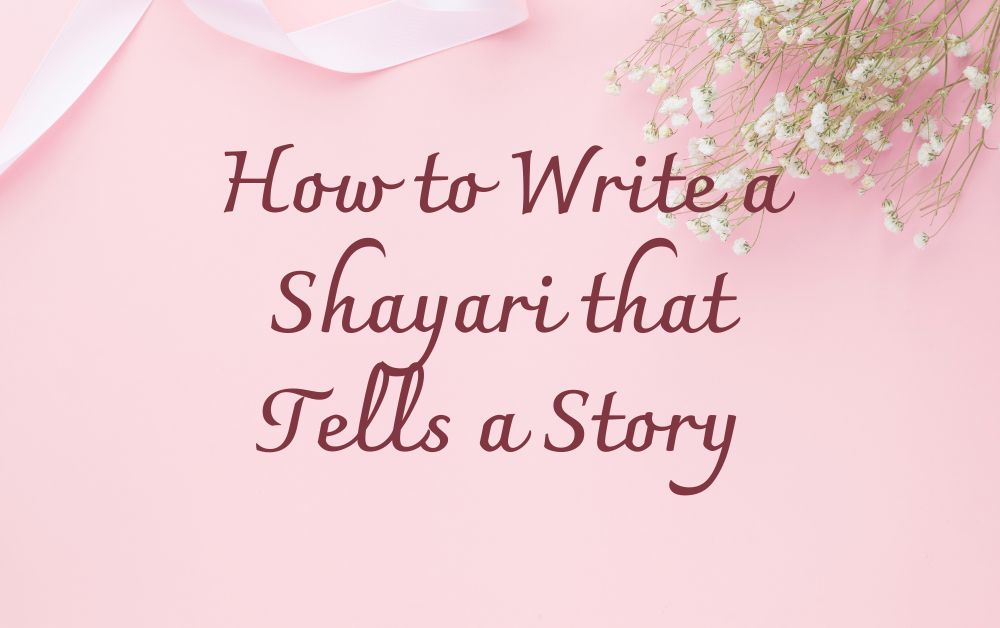a form of poetry that originated in South Asia, is known for its beautiful use of language and emotion. It’s a way to express feelings and thoughts through short verses. Writing Shayari that tells a story can be an incredibly fulfilling experience. This guide will help you understand how to craft Shayari that not only conveys deep emotions but also narrates a compelling story.
Understanding Shayari
What is Shayari?
Shayari is a form of Urdu poetry that expresses emotions such as love, sadness, joy, and sorrow. It often uses metaphors and similes to convey feelings in a beautiful and poignant way. Shayari can be written in various formats, but the most popular ones are Ghazals, Nazms, and Rubaiyat.
Note – Unlock the power of emotions with our stunning Instagram Shayari! Perfect for sharing your deepest feelings and connecting with your followers. Join our community of Shayari lovers and start expressing yourself in beautiful, poetic verses. Follow us now on Instagram for daily doses of inspiration and heartfelt poetry. Don’t miss out—share your Shayari and touch hearts today!
The Art of Storytelling in Shayari
Storytelling in Shayari involves weaving a narrative through your verses. It’s about creating a connection with the reader by taking them on a journey. This type of Shayari often has a beginning, middle, and end, much like a traditional story. The challenge is to convey this within the concise structure of Shayari.
Steps to Write a Shayari that Tells a Story
1. Choose a Theme or Topic
The first step in writing a Shayari that tells a story is to decide on a theme or topic. This could be anything from love and heartbreak to nature and personal growth. Your theme will guide the direction of your Shayari and help you stay focused.
Example Themes
- Love and longing
- Friendship and betrayal
- Personal growth and self-discovery
- Nature and its beauty
2. Create a Story Outline
Before you start writing, it’s helpful to outline the story you want to tell. This doesn’t have to be detailed, but having a rough idea of the beginning, middle, and end will make the writing process smoother. Think about the main events you want to include and how they connect to your chosen theme.
Example Outline
- Beginning: Introduction of characters and setting
- Middle: Development of the plot, including conflicts or challenges
- End: Resolution and conclusion
3. Use Vivid Imagery
Shayari is known for its use of vivid imagery and metaphors. These elements are crucial in bringing your story to life. Use descriptive language to paint pictures in the reader’s mind and evoke emotions. This will make your Shayari more engaging and memorable.
Example of Vivid Imagery
- Instead of saying “She was sad,” you could write “Her eyes were a stormy sea, waves crashing with each tear.”
4. Focus on Emotions
At the heart of every Shayari is emotion. Whether it’s love, sorrow, joy, or anger, your verses should convey deep feelings. Think about how your story makes you feel and try to capture that in your writing. Use expressive language to connect with the reader on an emotional level.
Example of Expressing Emotion
- Instead of saying “He loved her,” you could write “His heart beat her name with every breath, a melody of endless devotion.”
5. Keep it Concise
One of the challenges of writing Shayari is keeping it concise. Unlike traditional stories, Shayari is typically short and to the point. Focus on the most important aspects of your story and avoid unnecessary details. Each word should add value to the overall narrative.
Example of Conciseness
- Instead of writing a long description of a sunset, you could write “The sky blushed as the sun kissed the horizon goodbye.”
6. Use Rhymes and Rhythm
Shayari often features rhymes and a rhythmic flow. This musical quality adds to the beauty of the verses and makes them more enjoyable to read. Experiment with different rhyming schemes and meters to find what works best for your story.
Example of Rhyming
- Instead of writing “She waited for him every day,” you could write “Day after day, she waited by the bay.”
7. Revise and Edit
Writing Shayari is a process that involves revision and editing. Don’t be afraid to make changes to improve your verses. Read your Shayari out loud to check the flow and rhythm. Make sure each line contributes to the overall story and emotion.
Tips for Revision
- Remove any unnecessary words or lines
- Ensure each verse is clear and meaningful
- Check for consistency in tone and style
Example Shayari that Tells a Story
Theme: Love and Heartbreak
Outline:
- Beginning: A couple in love
- Middle: Separation due to unforeseen circumstances
- End: Acceptance and moving on
Shayari:
In the garden of our dreams, we danced with the flowers, Hand in hand, we whispered secrets for hours.
But fate had a different path to pave, Our love was tested by a relentless wave.
Distance grew, and hearts began to ache, Promises once made, now seemed to break.
Yet in the silent nights, under the moon’s gentle light, Memories of us, still held me tight.
With tears in my eyes, and strength in my heart, I learned to let go, and make a new start.
Tips for Writing Better Shayari
1. Read and Listen to Shayari
To improve your Shayari writing skills, immerse yourself in the works of renowned Shayars (poets). Read and listen to their Shayari to understand different styles, themes, and techniques. This will inspire you and help you develop your unique voice.
Famous Shayars to Explore
- Mirza Ghalib
- Allama Iqbal
- Faiz Ahmed Faiz
- Javed Akhtar
2. Practice Regularly
Like any form of writing, practice is key to improving your Shayari skills. Write regularly, even if it’s just a few lines each day. Experiment with different themes and styles to find what resonates with you.
3. Join Shayari Communities
Joining Shayari communities, both online and offline, can be beneficial. You can share your work, receive feedback, and learn from other Shayars. These communities can also provide inspiration and support.
Online Platforms for Shayari
- Facebook groups
- Poetry forums and websites
4. Keep a Journal
Keep a journal to jot down your thoughts, feelings, and ideas. This can be a valuable resource when you’re looking for inspiration. Review your journal entries regularly to find themes and emotions to incorporate into your Shayari.
5. Embrace Your Unique Voice
Every Shayar has a unique voice and perspective. Don’t try to imitate others too closely. Embrace your individuality and let your personal experiences and emotions shine through your Shayari.
Conclusion
Writing Shayari that tells a story is a beautiful way to express your emotions and connect with others. By choosing a theme, creating a story outline, using vivid imagery, and focusing on emotions, you can craft Shayari that resonates with readers. Remember to keep it concise, use rhymes and rhythm, and revise your work for clarity and impact. With practice and dedication, you can develop your unique voice and become a skilled Shayar.
For more insightful articles related to this topic, feel free to visit algo360i














